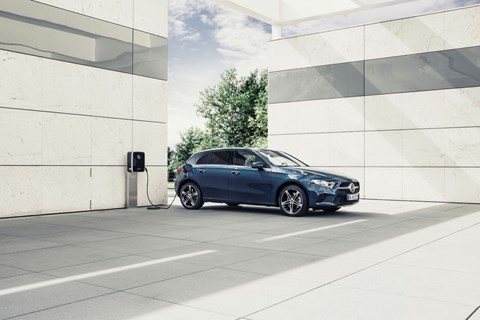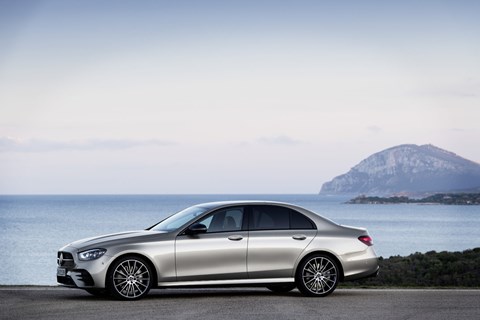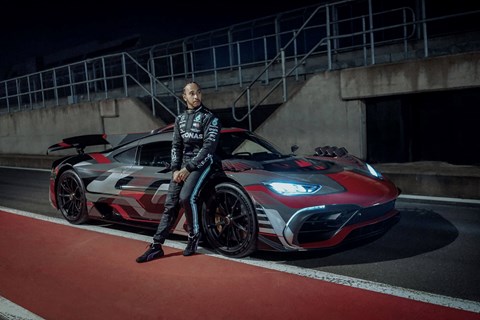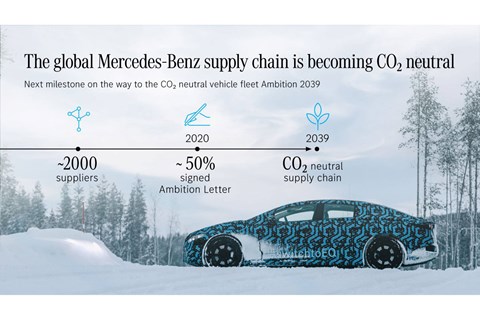► Mercedes hybrids explained
► Plug-in and mild-hybrid models
► AMG's hybrid future
Current Mercedes models and future ones are leaning heavily on hybrid tech in order to achieve more power, lower emissions, and better fuel economy. Even now, a quarter of Mercedes vehicles sold in Europe are hybrid or pure electric.
But with Mercedes being Mercedes, its hybrid structure and model lineup needs some explaining.
Here are some handy links to navigate this article:
Mercedes EQ Power (plug-in hybrids)
EQ Power refers to Mercedes-Benz's plug-in hybrids. These cars give you the option to run on pure electric, fossil fuel, or a combination of the two. Electric power is designed for city driving and short trips, whereas the petrol/diesel option gives you longer range for longer drives. You can recharge the batteries via a plug or by using the car's engine.
What does this actually translate to? Let's take Mercedes' little A Class hatchback (below) as an example.

The plug-in hybrid A Class is the A250e has a 1.3-litre petrol engine like the A180 and A200 models. The 10.6kWh battery in the A250e makes it a hefty 300kg more than the A200.
What you get in return is a combined power of 218bhp. That's an extra 55bhp and a whopping 148lb ft of torque over the A200. The A250e is 1.4 seconds faster to 60mph (6.6 seconds), plus it has a WLTP-backed fuel consumption of 280mpg. Take that with a grain of salt. Official electric range is 44 miles - another figure to consume with sodium.
The A250e's boot is a little smaller than the A200's (310 litres compared to 355 litres) and in the same trim level, the A250e is about £3,000 more than the A200.
Check out our Mercedes A250e hybrid review
The Mercedes plug-in hybrid range also includes the B Class, C Class, CLA, E Class, GLA, GLC, GLE, and the S Class.
In short, Merc's plug-in hybrids return better fuel economy and much lower emissions than petrols in return for a higher asking price and smaller boot.
Mercedes EQ Power hybrid models include:
A250e
B250e
CLA 250e
C300e and C300de
E300e and E300de
S Class (coming in 2021)
GLA 250e
GLC 300e and GLC 300de
GLE 350de
Mercedes EQ Boost (mild-hybrids)

Plug-ins are not the only hybrids in the Mercedes lineup. There are also mild hybrids.
While these cars do have electric power, they do not have the option to be used on their own and cannot be charged by plugging in. Instead, they are charged by and work with the combustion engine, filling in the power gaps to give smoother and more efficient power delivery, improved fuel economy, and a slight power bump too.
EQ Boost is fitted as standard to many petrol Mercedes models, including:
Mercedes EQ Boost hybrid models:
Mercedes C200 and C300
Mercedes CLS 300d
Mercedes-AMG CLS53
Mercedes E200 and E450
Mercedes S500 (coming in 2021)
Mercedes GLC 300
Mercedes GLE 450
Mercedes-AMG GLE 53 and GLE 63 S
Mercedes-AMG GLS 63
Mercedes-Maybach GLS 600
What about AMG?
Hybridisation isn't filtering into Merc's performance division, it's flooding in.
Acting as the poster child for Mercedes-AMG's revolution from souper-upper to standalone maker is the One hypercar (below ) – the road-going F1 car that is due for launch later this year. The One will have a reworked version of the 1.6-litre hybrid used in the Mercedes F1 car, generating over 1,000bhp.
Keep up to date with the Mercedes-AMG One
In terms of 'normal' upcoming AMG models, they too will be all about hybrid technology. To squeeze a very long story into a nutshell, there is a whole new performance hybrid layout for forthcoming AMG models that Mercedes has labelled the P3.
The P3 layout works by using the 2.0-litre four cylinder and 4.0-litre V8 engines seen in current Mercedes AMG models and coupling them to a new electric motor that will sit over the rear axle and with its own two-speed transmission. So yes, your future AMG model will have two motors and two transmissions.

For example, the new C Class will have an AMG C63 variant coming in 2022, and it will use the new 2.0-litre hybrid layout.
We know how potent that turbocharged motor is in the A45 S, but the AMG engineers have been at work at it again and claim to have increased power further to over 440bhp. Combine that with the electric motor developing up to 150kW (201bhp), and the future C63 will be at least as powerful as its V8 predecessor and allegedly more flexible, according to Mercedes – albeit without the thunderous soundtrack.
The 4.0-litre V8 hybrid layout is likely to be used first in the upcoming Mercedes-AMG GT73 later on this year, then followed up by AMG's take on the new SL (the non-AMG SL will use hybrid tech too in the form of EQ Boost).
There is full-electric power coming to AMG too in something Mercedes has called, 100 percent emotions, zero emissions. AMG will use both its own exclusive platforms, as well as making AMG versions of EQ models.
Like the forthcoming EQ models, the AMG versions will use the 400-volt lithium-ion batteries, albeit with a new wiring harness, meaning it will be adapted more for AMG-style high-capacity performance. Additionally, the electric motors to be used will rev up to 18,000rpm, allowing for top speeds of up to 155mph. AMG has also talked about sound remaining part of the AMG experience, so we wait in anticipation of how it pulls that off.
Mercedes Me Charge
Mercedes me Charge gives customers access to a number of charging networks including the UK's largest charge network, Polar, in one app (via a subscription).
But in fairness, the Mercedes me app does make things easier in regards to vehicle charging.
Read more about the future of car apps
Mercedes sustainable construction
One of the main criticisms that anti-EV people have about electrification is the claim that EVs and hybrids are no greener because of the production process. Mercedes has drawn itself up a list of future goals and a CO2-neutral supply chain by 2039 is one of them.

Crucially, Mercedes is aiming to ensure that the batteries it buys from suppliers are produced using carbon-neutral production. In fact, Mercedes already claims that the batteries it buys for the highly anticipated EQS saloon (featured in the June 2021 issue of CAR) are made using carbon-neutral production.
At the other end of lifespan, Mercedes has built up its car recycling and scrappage services in the UK. Mercedes has paired up with Autogreen Ltd in order to provide an authorised car recycling and scrapping network.